Biology 11 Taxonomy Unit
1/36
Earn XP
Description and Tags
Main purpose: memorize and practice descriptions + characteristics of the following categories -Three domains -Kingdom characteristics -Taxonomy -Phylogenetics -Phylogeny
Name | Mastery | Learn | Test | Matching | Spaced |
|---|
No study sessions yet.
37 Terms
Domain Archaea
Definition: resemblance of the most ancient of life on Earth
Characteristics: Unicellular, prokaryotic, some autotrophs, some heterotrophs, primarily asexual, includes extremophiles
Examples: thermophiles, halophiles, methanogens
Domain Bacteria
Characteristics: unicellular, prokaryotic, enclosed organelles, some autotrophs, some heterotrophs, primarily asexual
Examples: E.coli, Salmonella, Streptococcus
Domain Eukarya
Description: a domain that contains all eukaryotic organisms that is divided into 7 conventional classifications:
Kingdom, phylum, class, order, family, genus and species
Characteristics: Eukaryotic
Kingdom Plantae
Characteristics: multicellular, eukaryotic, autotrophs, go through photosynthesis, both sexual and asexual reproduction, sessile
Possesses organelles specific to plants: a cell wall, chloroplasts, and large central vacuoles
Examples: moss, ferns, conifers, flowering plants
Kingdom Animalia
Characteristics: multicellular, eukaryotic, heterotrophs, reproduce sexually, motile
Examples: zebra, human, dog, fish, lizard, sponge, jellies, worms, etc.
Kingdom Fungi
Characteristics: unicellular, colonial, multicellular, eukaryotic, cell wall made up of chitin, heterotroph, sexual and asexual reproduction, sessile
Examples: toadstool, mushroom, mold, yeasts
Kingdom Protista
Description: the “catch-all” or “junk drawer” of kingdoms. Any life forms that don’t particularly fit anywhere else, are put into this kingdom
Characteristics: multicellular, unicellular, colonial, eukaryotic, heterotrophs and autotrophs, sexually and asexually reproduce
Examples: volvox, paramecium, seaweeds, etc.
Basis for Classifying Organsims
Organisms are classified into levels of taxa (taxon) based on structural similarities (similarities in DNA).
An organism’s classification reflects its evolution
Domains are divided into 7 categories:
-Kingdom
-Phylum
-Class
-Order
-Family
-Genus
-Species
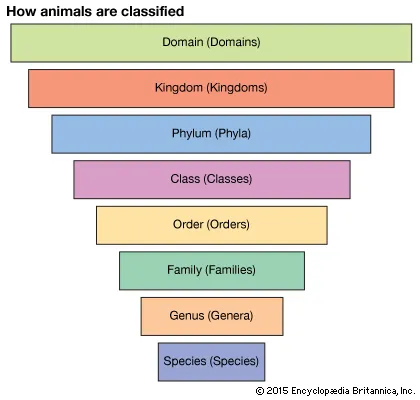
Levels of Classification from Least Specific to Most Specific
Kingdoms: contain the fewest shared characteristics
Species: contain the smallest number of organisms with the greatest number of similarities
Nomenclature
The binomial system used to write scientific names
Consists of a genus name, followed by the species name, and may also include a third name following the species name. Both names are either underlined separately or italicized
Genus name: always capitalized
Species name: written in lowercase
Taxonomy
Classification of organisms that shows us where the species considered diverged from its relatives
Dichotomous Key
A tool used to identify an organism with the purpose of separating characteristics of similar appearing organisms to identify unknown species
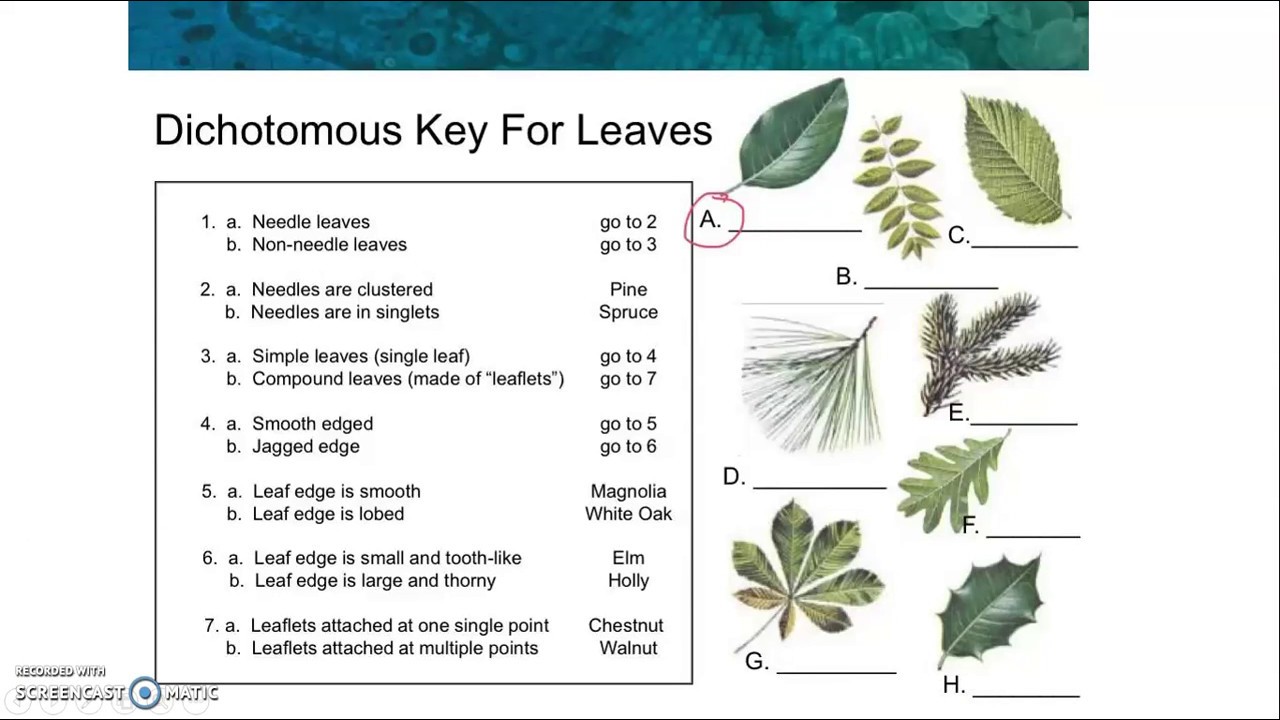
Autotroph + heterotroph
Autotroph: converts inorganic molecules to organic molecules to obtain energy, making its own energy source
Heterotroph: Consume organic molecules to obtain energy
Eukaryotic + prokaryotic
Eukaryotic: cells possess a nucleus and membrane-bound organelles, but lack a cell wall
Prokaryotic: cells lack a nucleus and membrane-enclosed organelles
Multicellular + unicellular
Multicellular: consists of multiple interdependent cells
Unicellular: consists of one singular cell
Asymmetry
Lack of symmetry (regularity in a shape), irregularly shaped, tends to be sessile
Example: Sponge
Radial Symmetry
Body parts radiate out form a central point, organisms lack a true head, characterized by a top side and bottom side, tend to be slow-moving or sessile
Example: jellies (jellyfish), anemone, sea star (pentaradial symmetry)
Bilateral Symmetry
Characterized by two-sided symmetry, body parts repeat on either side of the organism if you were to cut it in half, two halves are mirror images of each other, and organisms tend to be more complex
Most organisms with a backbone tend to be bilateral, and efficient movers
Examples: Worms, snails, leach, most invertebrates, shellfish, lobster, humans
Dorsal
Upper surface of a bilateral animal
Ventral
Lower surface of a bilateral animal
Anterior
Head of a bilateral animal
Animals that have a central nervous concentrated at the head is termed cephalization
Posterior
Tail end of a bilateral animal
Oral
Mouth is present near the anterior (head) end of organism
Aboral
Mouth is present near the posterior (anus) end of organism
Phylogeny
Refers to the evolutionary history of a species or group of species, used to determine relationships between living things, patterns of descent/ ancestry, and correct classification of organisms
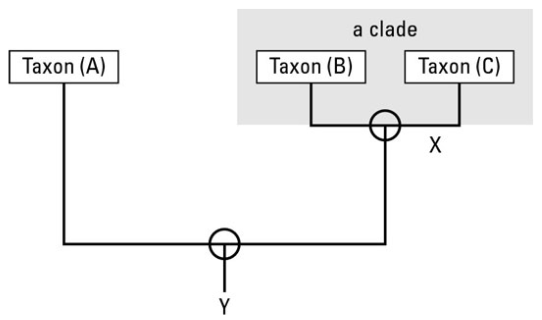
Phylogenetic Tree
common ancestor found at the base of the tree
Tips of branches represent species or other taxa
Branches meet at points called nodes that represent the common ancestor of the two taxa
Groups that share an immediate common ancestor are called sister groups
Ancestors plus all descendants form a clade
Branch that separates at the base is called an outgroup
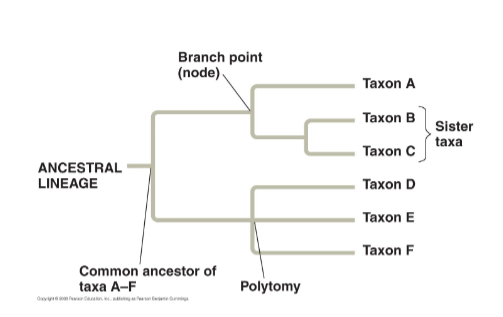
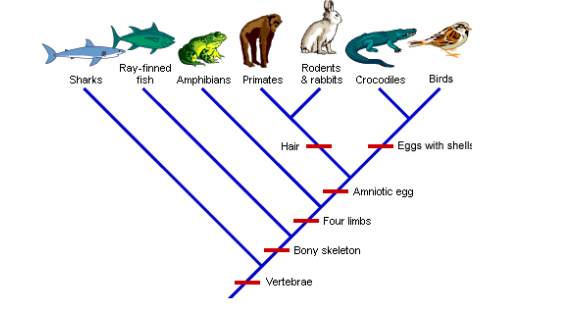
Cladogram
Type of phylogenetic tree which may be constructed based on shared derived traits or synapomorphies
Advantages of using scientific names
A universally used name prevents miscommunication and confusion
The use of Latin names prevents changes in language
Many common names do not accurately represent organisms, inducing misunderstanding (Jellyfish ≠ fish)
Only one scientific name is used for each species
One scientific name refers to only a single species
Thermophiles
Bacteria that thrive in extremely hot environments
EX: volcanic springs, deep sea vents
Halophiles
Bacteria that inhabit in high salt environments
Methanogens
Bacteria that inhabit and thrive in environments with high amounts of methane
EX: sewage treatment plants, guts of cattle
Name the list classifying organisms
Domain, kingdom, phylum, class, order, family, genus, species
Acronym: (Dumb) Kids Play Catch Over Farmer Green’s Shed
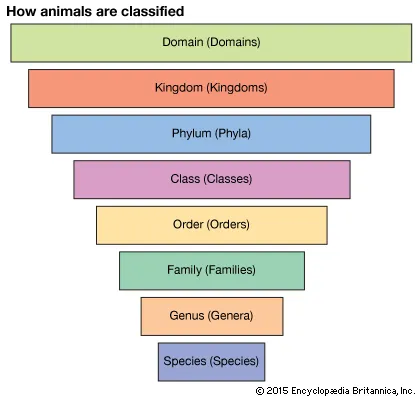
Organic vs Inorganic molecules
Organic molecules: consist of carbon and hydrogen, both MUST be present
Example: Methane (CH4), Glucose (C6H12O6)
Inorganic molecules: lack either/or carbon or hydrogen
Example: Water (H20), Carbon dioxide (C02)
Synapomorphies
Shared traits that evolved only by members of the group that have been inherited from a singles common ancestor in which the features first evolved
Morphologies
Definition: Structural observation
Analogous + homologous
Analogous structures: species appear similar and have similar functions, but have different internal structures
Homologous structures: species appear different with different functions, but have similar internal structures
Convergent Evolution
Different populations of organisms are exposed to similar environmental selective pressures and similar structures form as a result